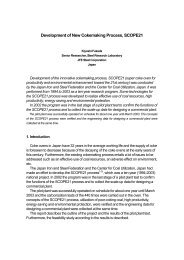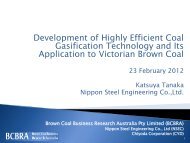Defining CCS Ready: An Approach to An International Definition
Defining CCS Ready: An Approach to An International Definition
Defining CCS Ready: An Approach to An International Definition
- No tags were found...
Create successful ePaper yourself
Turn your PDF publications into a flip-book with our unique Google optimized e-Paper software.
Chapter 1: Introductionor more, licensed after the effective date of the EU Directive, must assess whether thefollowing conditions are met:1) suitable CO 2 s<strong>to</strong>rage sites are available;2) transport facilities are technically and economically feasible; and3) retrofit for CO 2 capture is technically and economically feasible.If the conditions are met, the competent authority shall ensure that suitable space on theinstallation site is set aside for the equipment necessary <strong>to</strong> capture and compress CO 2 .Note that although the EU Directive does not use the phrase “<strong>CCS</strong> <strong>Ready</strong>,” the provisionsare consistent with the <strong>CCS</strong> <strong>Ready</strong> concept.UK GuidanceFollowing on the EU Directive, the United Kingdom (UK) developed a guidance documentindicating how aspects of the EU directive will be implemented in England and Wales. Thedocument focuses on new applications for power stations at or over 300 MW in Englandand Wales, wherein the developers have <strong>to</strong> demonstrate that their plant is carbon captureready in order <strong>to</strong> be granted consent for construction.Applicants are asked <strong>to</strong> demonstrate that there are no known technical or economicbarriers that would prevent the installation and operation of chosen <strong>CCS</strong> technologies (“nobarriers” approach). At the same time, applicants are directed <strong>to</strong> apply for HazardousSubstances Consent if <strong>CCS</strong> will involve the use of hazardous substances.The Guidance requires developers <strong>to</strong> consider suitable means of CO 2 transport <strong>to</strong> a selectedoffshore s<strong>to</strong>rage site, in addition <strong>to</strong> specific planning requirements for retrofitting capture andcompression equipment at the plant site. Specifically, the applicant must demonstrate:• that sufficient space is available on or near the site <strong>to</strong> accommodate carbon captureequipment in the future;• the technical feasibility of retrofitting the chosen carbon capture technology;• that a suitable area of deep geological s<strong>to</strong>rage offshore exists for the s<strong>to</strong>rage of capturedCO 2 from the proposed power station;• the technical feasibility of transporting the captured CO 2 <strong>to</strong> the proposed s<strong>to</strong>rage area;and• the likelihood that within the power station's lifetime it will be economically feasible <strong>to</strong>link it <strong>to</strong> a full <strong>CCS</strong> chain covering retrofitting of capture equipment, transport, ands<strong>to</strong>rage.The UK Guidance defines how all of these points are <strong>to</strong> be achieved through alist of key criteria and requirements that must be met by applicants. The UKGuidance is detailed and its provisions are well reasoned. The “no barriers” approach of theUK guidance ensures that potential future barriers have been considered and accounted for,thereby minimising the risk of future time delays <strong>to</strong> the deployment of <strong>CCS</strong>.23 February 2010 11
















